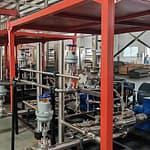Liquid Nitrogen pump
A cryogenic pump is a specialized type designed to handle and transfer cryogenic fluids at extremely low temperatures, typically below -150 degrees Celsius (-238 degrees Fahrenheit).
Cryogenic fluids include liquefied gases such as liquid nitrogen (LN2), liquid oxygen (LOX), liquid helium (LHe), and liquefied natural gas (LNG).
DSW, based in China, is a leading manufacturer of cryogenic equipment, including cryogenic pumps and turbo-expanders for customers worldwide.
We offer a range of cryogenic pumps for applications such as LNG, industrial gases, and superconducting magnets.
Main Technical Parameters:
| Working pressure | 35-150MPA |
| Flow | 100lL/H-10000L/H |
| Operation conditions | Hygrogen gas buffer,offershore plateform |
Several types of cryogenic pumps, such as liquid nitrogen, liquid oxygen, and liquid helium, are designed for various applications in handling cryogenic fluids. Some common types include:
- Turbomolecular Pumps: These pumps use high-speed rotating blades to create a high-velocity gas flow, which helps pump gases at low pressures. They efficiently handle clean, dry gases and are often used in high-vacuum applications.
- Leybold Cryogenic Pumps: Also known as cryosorption pumps, these utilize the adsorption of gases on a cold surface to achieve pumping action. They operate at cryogenic temperatures and efficiently pump noble gases and hydrogen.
- Mechanical Cryogenic Pumps: These pumps use mechanical mechanisms such as pistons or diaphragms to compress gases and achieve pumping action at cryogenic temperatures. They are often used in cryogenic systems to liquefy gases.
- Centrifugal Cryogenic Pumps: These pumps use centrifugal force to move cryogenic fluids. They are commonly used in applications requiring a continuous flow of cryogenic liquids, such as large-scale industrial processes.

Features
Low Temperature: LN2 pumps are designed to operate in icy environments. They are constructed with materials and components that withstand low temperatures without embrittlement or other adverse effects.
Thermal Insulation: Cryogenic pumps often incorporate thermal insulation to minimize heat transfer from the surrounding environment. This insulation helps maintain the low temperature of the pumped cryogenic fluid and prevents excessive heat gain.
Specialized Sealing: Cryogenic liquid pumps utilize technical sealing mechanisms to seal the pump effectively and prevent leaks or loss of cryogenic fluids. These seals are designed to accommodate low temperatures and prevent the ingress of ambient air, which could cause vaporization or icing.
Cryogenic Fluid Compatibility: Cryogenic pumps are designed to handle specific cryogenic fluids, and the materials used in their construction are chosen to be compatible with those fluids. This ensures that the pump components do not react with or become damaged by the pump’s cryogenic fluids.
Pumping Mechanisms: Cryogenic liquid pumps can employ various pumping mechanisms, including centrifugal pumps, reciprocating pumps, or turbomolecular pumps, depending on the specific application and requirements. These pumps are designed to handle the unique properties of cryogenic fluids, such as low viscosity and high density.
Safety Considerations: Cryogenic pumps require special safety measures due to the extreme cold and potential hazards of cryogenic fluids. These measures may include safety interlocks, pressure relief systems, and proper handling procedures to ensure the safe operation of the pump.

Applications
Cryogenic pumps find applications in various industries, including aerospace, medical, research, and energy. They are used for tasks such as transferring cryogenic fluids between storage tanks, supplying cryogens for scientific experiments, cooling superconducting magnets, or providing fuel for cryogenic rocket engines. The design and construction of cryogenic pumps are tailored to the specific requirements and challenges of handling fluids at ultra-low temperatures.














